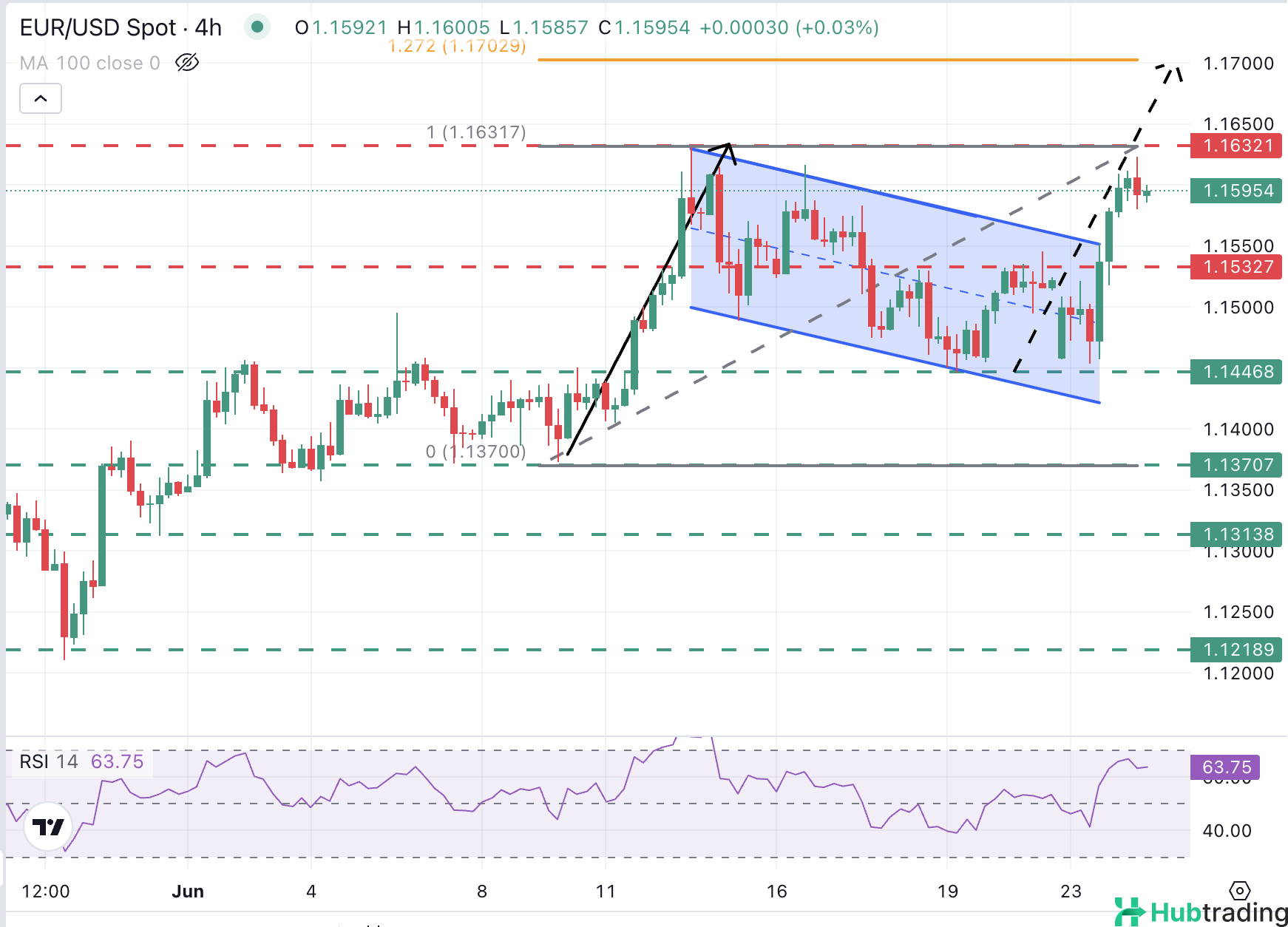- Improved risk appetite is supporting global markets and limiting downside pressure on the Euro.
- A steep drop in oil prices is providing additional tailwinds for the common currency.
- EUR/USD has broken out of the top of a bullish flag pattern and is now targeting the 1.1630 and 1.1700 resistance levels.
The EUR/USD pair edged slightly lower below the 1.1600 mark during Tuesday’s European session but continues to trade well above Monday’s lows, following heightened volatility driven by geopolitical developments. The pair had surged roughly 1.30% from Monday’s trough after U.S. President Donald Trump announced a "complete and total ceasefire" in the Israel-Iran conflict.
However, tensions resurfaced after Israel accused Iran of violating the truce by launching missiles into its territory, prompting threats of retaliation. Tehran has denied the allegations. While risk appetite has cooled slightly, the U.S. Dollar remains under pressure, and oil prices have pared some of their earlier losses.
Crude oil is down nearly 3% on Tuesday, extending Monday’s steep 13% drop. West Texas Intermediate (WTI) prices have retreated to around $63.00 per barrel after trading above $77.00 just days ago. The sharp decline in oil prices offers relief to the Eurozone, a major net importer of crude, as lower energy costs ease inflationary pressures on an already fragile economic recovery.
With geopolitical risks temporarily subsiding, market attention now turns to Federal Reserve Chair Jerome Powell’s testimony before Congress at 14:00 GMT. Investors are keen to gauge whether Powell will maintain a cautious, data-dependent stance or align with recent dovish comments from other Fed officials advocating for a rate cut in the near term.
Daily Digest Market Movers: Risk-On Mood Pressures US Dollar as Ceasefire Spurs Rally
- Markets are in the midst of a relief rally following the announcement of a ceasefire between Israel and Iran, easing fears of a broader regional conflict that had escalated after U.S. involvement over the weekend. The U.S. Dollar Index (DXY), which tracks the USD against a basket of six major currencies, has dropped over 1% since the truce was declared, erasing much of the ground it gained over the past two weeks.
- Tensions spiked when Iran launched missiles into Israeli territory—killing four—in retaliation for a U.S. military base attack in Qatar that resulted in no injuries. Tehran’s Foreign Minister later stated that Iranian strikes would cease only once Israel halts its air attacks. Despite lingering uncertainty, markets are treating the ceasefire as a turning point, prompting a surge in risk appetite and a pullback in safe-haven flows.
- On the data front, Germany’s IFO Business Climate Index rose to 88.4 in June from 87.5 in May, slightly exceeding expectations of 88.3. Business expectations also improved to 90.7, surpassing the consensus forecast of 90.0. However, the Euro saw limited reaction, as markets had already priced in moderate optimism.
- Eurozone flash PMI figures for June showed business activity holding steady. The Manufacturing PMI printed at 49.4, while Services came in at 50.0—both roughly in line with last month’s readings but slightly below market hopes, prompting a mild retreat in the Euro.
- In contrast, U.S. preliminary S&P Global PMI data beat forecasts. The Manufacturing PMI remained unchanged at 52, defying expectations of a slowdown to 51. Meanwhile, Services PMI eased slightly to 53.1 from 53.7 but still topped the consensus estimate of 52.9, providing some cushion for the USD.
- The spotlight now shifts to Federal Reserve Chair Jerome Powell, who will deliver the Semiannual Monetary Policy Report to Congress on Tuesday and Wednesday. Powell is expected to face questions about the Fed’s response to slowing economic growth and persistent inflationary pressures. His testimony comes on the heels of dovish remarks from Fed Governors Michelle Bowman and Christopher Waller, who both signaled support for rate cuts as early as July.
- In response, markets have increased their bets on monetary easing. According to CME Group’s FedWatch Tool, the probability of a July rate cut has risen to 22% from 14% last week, while the odds of a September cut have climbed above 80%, up from under 70%.
EUR/USD Breaks Higher, Eyes 1.1630 and Beyond

The EUR/USD pair has broken above the top of a multi-week corrective channel, buoyed by improved risk sentiment and broad USD weakness. Bulls are now targeting the June 12 high at 1.1630.
The breakout above trendline resistance at 1.1540 has confirmed a bullish flag formation. The pattern’s measured move points to a target near 1.1700, coinciding with the 127.2% Fibonacci extension of the June 10–12 rally.
On the downside, any bearish pullback may seek support at the broken trendline, now acting as a potential floor around 1.1535. A confirmed move below this level would invalidate the bullish setup and refocus attention on support near the June 19 and June 22 lows at 1.1445.





